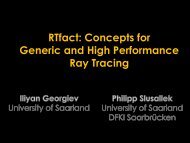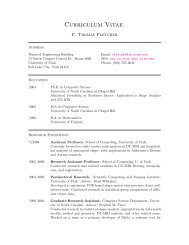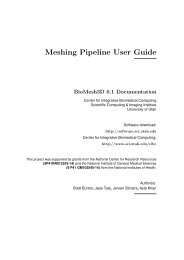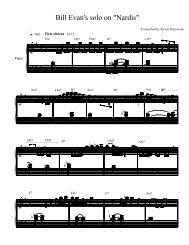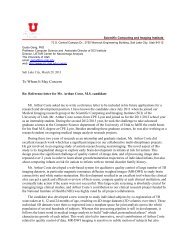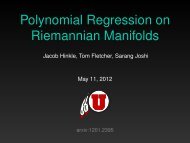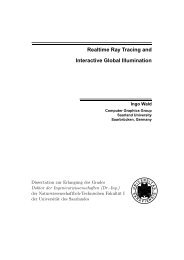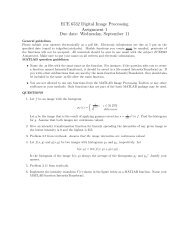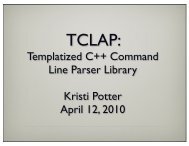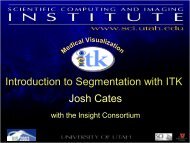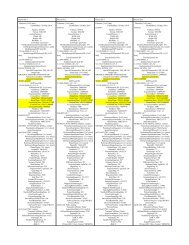SCIRun Forward/Inverse ECG Toolkit - Scientific Computing and ...
SCIRun Forward/Inverse ECG Toolkit - Scientific Computing and ...
SCIRun Forward/Inverse ECG Toolkit - Scientific Computing and ...
You also want an ePaper? Increase the reach of your titles
YUMPU automatically turns print PDFs into web optimized ePapers that Google loves.
ventricles of the heart, the sources are better modeled in more complex form to capture the<br />
wavefront of this activation. Each type of source then requires an approximation in mathematical<br />
<strong>and</strong> then numerical form. Such a source model can then be used (in a solution to<br />
the forward problem) to computationally generate the associated voltages on the surface of<br />
the body (or wherever measurements might be made). If the goal is to recover sources from<br />
measured potentials, i.e. to solve the inverse problem, such as in the activation sequence<br />
reconstruction just mentioned, the solution strategy must include appropriate numerical<br />
techniques that can incorporate constraints <strong>and</strong> recover useful solutions, even when the<br />
inverse problem is poorly posed <strong>and</strong> hence the forward problem numerically ill-conditioned.<br />
Creating complete software solutions to such problems from scratch is a daunting undertaking,<br />
requiring both considerable resources <strong>and</strong> considerable breadth of expertise. It<br />
is in order to make such tools more accessible to a broader array of researchers, <strong>and</strong> to<br />
enable validation <strong>and</strong> comparison across solution approaches, that the Center for Integrative<br />
Biomedical <strong>Computing</strong> (CIBC) has created this <strong>ECG</strong> <strong>Forward</strong>/<strong>Inverse</strong> toolkit. It is<br />
designed to provide a generalized software environment, based on the open-source <strong>SCIRun</strong><br />
system, to aid researchers to construct, execute, visualize, <strong>and</strong> compare such computational<br />
models.<br />
<strong>SCIRun</strong> is based on a data flow-visual programming paradigm, in which distinct computational<br />
(<strong>and</strong> software) modules are linked by connections (“data pipes”) to form functional<br />
networks. The network editor offers the user interactive control <strong>and</strong> flexibility to<br />
assemble the specific network needed to solve the computational task at h<strong>and</strong>. The <strong>ECG</strong><br />
<strong>Forward</strong>/<strong>Inverse</strong> toolkit provides a diverse array of modules, with associated data types, for<br />
bioelectric field problems, together with sample networks <strong>and</strong> data sets with which to explore<br />
its functionality. An additional key feature of using the <strong>SCIRun</strong> system is that rather<br />
than requiring custom code for all its functionality, the toolkit leverages <strong>SCIRun</strong>’s ability to<br />
connect directly to Matlab through a bi-directional Matlab interface, <strong>and</strong> has capabilities<br />
to read in data created by <strong>ECG</strong>Sim, as mentioned above.<br />
Table 1.1 lists currently available forward <strong>and</strong> inverse approaches explicitly provided<br />
within the toolkit. The toolkit contains full simulation example networks that illustrate potential<br />
<strong>and</strong> activation-based forward models using both finite element (FEM) <strong>and</strong> boundary<br />
element (BEM) approximation techniques as well as selected potential <strong>and</strong> activation-based<br />
inverse methods. As indicated by the table, simulation specific tools, such as lead field <strong>and</strong><br />
stiffness matrix generators, as well as a variety of regularization modules, are also included,<br />
<strong>and</strong> can easily be included in user-built networks.<br />
4 Chapter 1



